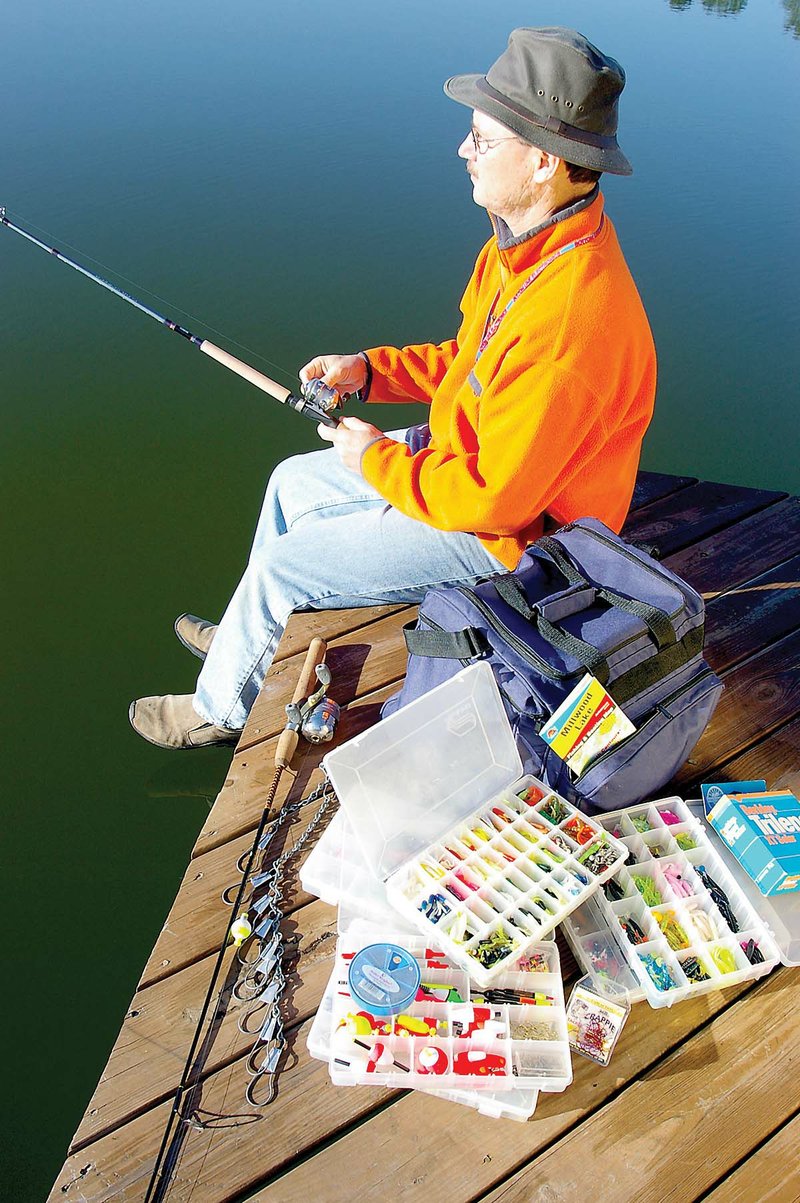My uncle Guy McClintock of Cherry Valley spent much of his life fishing for crappie. His fishing vessel was a 10-foot johnboat hand-crafted from cypress. His poles were hand-cut canes.
Not surprisingly, the tackle box he used was equally domestic — a coffee can into which he stuffed a few hooks, several yards of Dacron fishing line, some small corks and an aspirin bottle filled with split shot.
A crappie fan who fishes like my uncle did — with minnows and cane poles — may need nothing more than a simple little tackle box to store terminal tackle and line. A coffee can will suffice, although you may want something even simpler, like a shoe box or a zip-close bag.
If you’re like me, though, minnows and cane poles aren’t enough to satisfy. I frequently fish with shiners, but I also like working jigs, spoons, crankbaits, spinners and other crappie lures. I still love fishing with cane poles, but there are times when I’d rather be casting with a spinning combo or working heavy brush with a jigging pole. If crappie are hard to entice, I may switch lures and poles several times, trying to find the perfect combination. Consequently, I prefer a large tackle box in which to carry all my fishing paraphernalia.
Here’s some advice for selecting and stuffing a tackle box that is ideal for crappie fishing.
The Tackle box
There are innumerable styles of tackle boxes on today’s market. The one you select will depend largely on how much tackle you carry on each outing, the type of tackle you use and, if you’re budget-conscious, the price.
If you’re primarily a minnow fisherman, a small box to accommodate a selection of hooks, bobbers, sinkers and line may suit your needs perfectly. But if you fish both jigs and minnows, you’ll probably want something more elaborate.
I tried a variety of tackle boxes — cloth bags, over-and-unders, tilt-trays and more — before finding my favorite. Most didn’t have enough tray compartments to organize my jigs. And those that had an ample number of compartments didn’t have space for larger tackle such as line spools and extra reels.
In the end, I settled on a large cloth tackle bag that holds several worm-proof plastic boxes, each with dividers that can be custom-fit to create up to 24 compartments. I’ve configured the dividers so I have more than 100 compartments in which to organize different colors and sizes of jigs and jig heads, plus all the other lures and tackle I carry. The tackle bag also has several large pockets where I can store bulkier gear such as stringers, line and reels.
Check out the variety of tackle boxes and bags available through your sporting-goods dealer and study them to determine what type best suits your needs. Then invest in a top-quality model, and fill it with tackle to create your own ultimate crappie box. Here are some things you’ll need to get started.
Terminal Tackle
In my tackle bag, I keep a small compartmented box for organizing hooks, sinkers and bobbers.
I prefer No. 6 Aberdeen cricket hooks and No. 1, 1/0 and 2/0 gold Aberdeen minnow hooks. I keep several dozen of each size, mostly thin-wire models that do the least damage to fragile minnows and will bend enough to free from snags when fishing brush.
Split shot are the primary type of sinkers I use. I prefer those with small “ears” for easier removal and generally have 100 or more in sizes 8 to 3 in my bag.
Bobbers, or floats, are
also important items of crappie equipment. In addition to suspending the bait at the right depth and providing a visual cue that a fish has taken the bait, they also add weight so you can better cast those tiny 1/64- to 1/32-ounce lures. I usually keep 15 to 20 in my tackle bag, including fixed bobbers and slip bobbers made with foam, balsa and cork.
I keep an extra spool of 4- to 8-pound-test line for situations dictating light line and a spool of 17-pound line I use when fishing heavy brush. I use premium monofilament and consider fluorescent green or yellow line best. These colors are more
visible, which permits detection of the lightest strikes.
Jigs and Other Lures
Jigs are my favorite crappie lures. To be prepared for any situation, my tackle bag contains several styles, colors and weights. Ninety percent are 1/32-ounce, because that’s the size I find most productive in most situations. However, there are times and places where smaller or larger jigs prove more productive, so I carry a variety of larger and smaller models as well.
I also keep an assortment of small safety-pin spinners in my tackle bag. These can be snapped on a jig to add extra crappie-attracting flashiness and vibration in stained or muddy water. In addition, I carry a small selection of other crappie-catching lures to use when jig fishing isn’t productive. Among my favorites are 1/8- to 1/4-ounce spoons, mini-crankbaits, small in-line and horsehead spinners, and bladebaits.
Miscellaneous Equipment
The remaining equipment in my crappie bag consists of these items: an extra line-holder
reel that will fit any of my jigging poles, an extra ultralight spinning reel, two stringers, a Gerber multitool, reel oil, sunscreen, nail clippers (for trimming line), a digital fish scale, a fish-scaler tool, a fillet knife and a ceramic knife sharpener. That’s it. I have everything I need for most outings, and it’s all together in a small package ready for transport.
Of course, there’s no limit to the number of interesting items you can find to enhance your crappie fishing. And if you’re like me, you’ll be continually adding to your collection of “must-have” paraphernalia.
